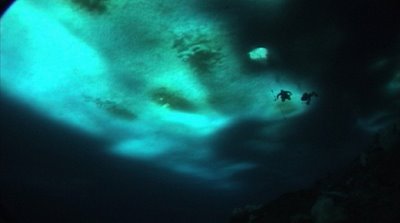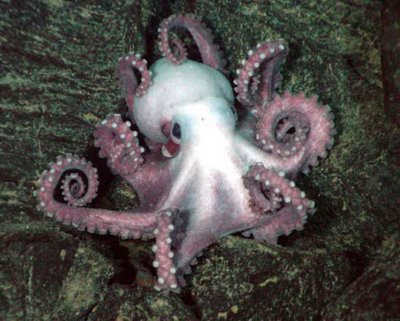 [Image: ©Renae Baker].
[Image: ©Renae Baker]."Some of the coldest temperatures on Earth brought a rare cloud formation to the skies over Antarctica," SF Gate reports. "Meteorological officer Renae Baker captured spectacular images of the nacreous clouds, also known as polar stratospheric clouds, last week at Australia's Mawson station."
 [Image: ©Renae Baker].
[Image: ©Renae Baker].Meanwhile, Wired introduced us last month to Werner Herzog's forthcoming science fiction film, The Wild Blue Yonder, which uses the undersea Antarctic seascape as a stand-in for liquid extraterrestrial environments.
 [Image: Werner Herzog/Wired – many more photos here].
[Image: Werner Herzog/Wired – many more photos here]."Instead of spending millions on Spielberg-style effects, Herzog went low tech and high geek," Wired writes. "He spliced together documentary footage from NASA and the National Science Foundation’s US Antarctic Program. He created 'characters' from documentary-style scenes with actual physicists and astronauts."
 [Image: Werner Herzog/Wired].
[Image: Werner Herzog/Wired].Apparently, whilst viewing "mesmerizing images of ethereal jellyfish and swarms of crystalline microorganisms mingling in a cobalt twilight beneath a 20-foot-thick sheet of ice," Herzog instinctively felt: "This is not our planet." (One assumes the sentiment should, in Herzog's case, be taken literally).
 [Image: Werner Herzog/Wired].
[Image: Werner Herzog/Wired].The film "opens with a wide shot," Wired explains: "A vast, vaulted ice canopy stretches over the horizon as two human silhouettes descend through a glowing portal into the dim indigo void. They fan out weightlessly, their breath echoing like whispers in an empty cathedral. Something approaches – a speck, silently swelling into what looks like a translucent bullet lined with undulating fringes of silk. The creature hovers in close-up, then darts away in a cascade of ice shards; dissonant music fades, then swells as the humans forge farther into the blue-green deep."
 [Image: NOAA – who, elsewhere, presents us with the literature of abysses].
[Image: NOAA – who, elsewhere, presents us with the literature of abysses].That "blue-green deep," however, is also an uncanny incubator of evolutionary weirdness. The deep sea octopus, for instance, first made its appearance in Antarctica's waters: "Australian researcher Dr. Jan Strugnell of Queen's University Belfast and the British Antarctic Survey says the formation of ocean currents around the continent millions of years ago provided the right conditions for ocean creatures to evolve," the Australian Broadcasting Corporation reports.
Amazingly, deep sea octopi appear to register, in their genes and anatomy both, the continental make-up of plate tectonics at the time of their earliest evolution – think of it as forensic landscape history at a biological remove: "About 34 million years ago, Antarctica separated completely from South America, with the opening up of Drakes Passage. This allowed the Antarctic Circumpolar Current to form, which insulated the continent and allowed it to get really cold. As cold water is more oxygen rich than warm water, oxygen from Antarctic waters would have been able to then diffuse into the deep seas along with Antarctic octopuses, which then evolved into deep sea octopuses. 'The opening of the Drakes Passage fits in with evolution of the group,' says Strugnell."
Which leads me to wonder if a specific mountain range in Africa – or Asia, for that matter – catalyzed an exact and specific thousand-year microclimate in which simian ingenuity could last across sufficient generations that some group eventually opposably-thumbed its way toward a larger brain. Or a certain valley, a specific rain corridor, a particularly comfortable belt of well-grassed savannahs – these landscapes could afford the time and space in which specific organisms would gradually develop themselves and evolve.
Writing this, of course, I realize how obvious it is that that's exactly what did happen; but, then, assuming someday we discover the exact mountain (or gorge) that helped produce a rain-shadow that helped produce a climate that helped produce a fertile niche in which tool-using hominins could hang-out long enough to discover gods, writing, and warfare, shouldn't that specific landmark receive some kind of protected, even vaguely familial, status? The Ur-mountain.
What if it's been turned into a copper mine?
Or if there is no such thing?
Reversing the question, of course, could you bulldoze, plow, till, and plant your way toward some wild mega-landscape specifically engineered – topographically, climatically, acidically, and so on – based upon how it will catalyze the evolution of new species in a hundred thousand years' time? Landscape architecture as a distant subset of genetic engineering: planting your garden based on what cross-hybridized evolutionary outgrowths may someday appear – but doing this on a continental scale, and with a time-frame of eons. Landscape futures, indeed.
Werner Herzog can film the design process.
A species will look back at its originary landscape, like an octopus drifting through Antarctic waters, overwhelmed with strange feelings of gratitude.
(Big thanks to Bryan Finoki for the Antarctic clouds article!)
No comments:
Post a Comment